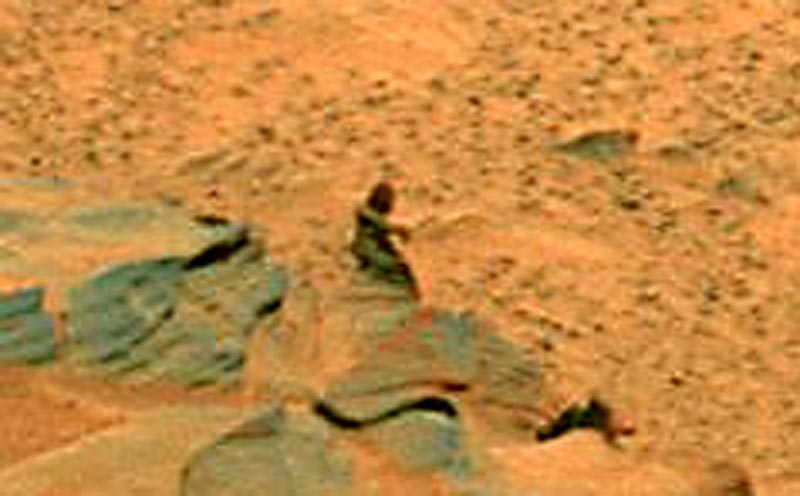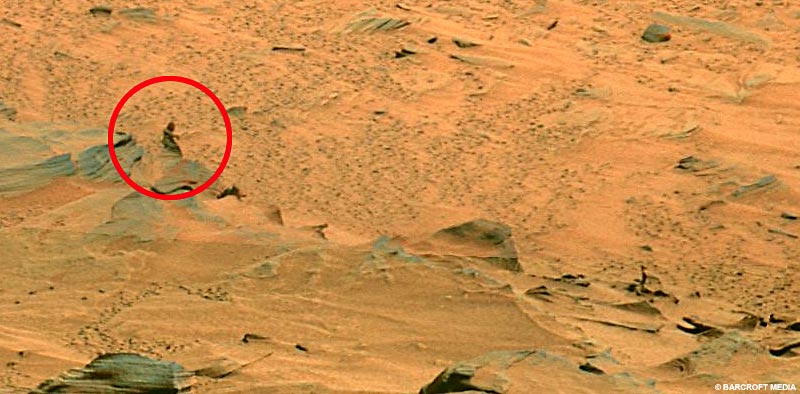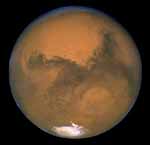|
|
| Photograph Proves - Life
on Mars
January 22, 2008  NASA scientists have been puzzled by the peculiarly life-like image which has been beamed back to earth by one of their two robot rovers that are currently trundling about the surface of the red planet, on the hunt for clues of life on Mars. It will delight spacewatchers who have been so far disappointed by the lack of images of little green men captured by the twin vehicles on their four year mission. The alien figure was pictured at the far left of one of the panoramic photographs taken by the exploration rover, Spirit, from the top of a low plateau in late 2007. The robot vehicle and its twin, Opportunity, have been roving around on Mars since completing their first successful mission in April 2004. Their principle goal is to hunt for geological evidence of water, that suggest an environment which may once have been hospitable to life. Having been launched from Cape Canaveral, in Florida, in June and July in 2003, they travelled 487 million and 456 million km respectively to opposite ends of the planet, where they went on to explore the dusty, rock-strewn landscape. 
Ice clouds found in Mars'
orange sky
A team of French scientists has found the existence of the clouds of dry ice, which sometimes become so dense that they throw quite dark shadows on the dusty surface of the red planet, using data obtained by the OMEGA spectrometer on board ESA's Mars Express. "This is the first time that carbon dioxide ice clouds on Mars have been imaged and identified from above. This is important because the images tell us not only about their shape, but also their size and density. "Previously, we had to rely on indirect information. However, it is very difficult to separate the signals coming from the clouds, atmosphere and surface," lead scientist Franck Montmessin of the Service dAeronomie at University of Versailles was quoted by the 'ScienceDaily' as saying. Not only are the clouds surprisingly high -- over 80 kms above the surface -- but they can be several hundred kilometres across. They are also much thicker than expected. Instead of looking like the wispy ice clouds seen on Earth, they resemble tall convectional clouds that grow as the result of rising columns of warm air. Even more surprising is the fact that the CO2 ice clouds are made of quite large particles -- more than a micron (one thousandth of a millimetre) across -- and they are sufficiently dense to noticeably dim the Sun. "The clouds imaged by OMEGA can reduce the Sun's apparent brightness by up to 40 per cent. This means that they cast quite a dense shadow and this has a noticeable effect on the local ground temperature. "Temperatures in the shadow can be up to 10'C cooler than their surroundings, and this in turn modifies the local weather, particularly the winds," Montmessin said. Since the CO2 clouds are mostly seen in equatorial regions, the OMEGA team believes that the unexpected shape of the clouds and the large size of their ice crystals can be explained by the extreme variations in daily temperature that occur near the equator. "The cold temperatures at night and relatively high day-time temperatures cause large diurnal waves in the atmosphere. This means there is a potential for large-scale convection, particularly as the morning Sun warms the ground," Montmessin said. |
|

|
| What is a Solar system |
| LUNAR COLLECTION | SOLAR COLLECTION | MARS | Home |
| India, New Delhi From Space |
|
|
|
|
|
|
|
|
|
|

Welcome to Swami Rajesh Chopra's |

|
( The Trade Marks Act, 1999, No. 01403083. User Since : 01/04/1997 ) All rights reserved. No part of this publication and other sites of under liveindia.com may be transmitted or reproduced in any form or by any means without prior permission from the publisher Live India Internet Services or Rajesh Chopra, L.C.Premium Cables, 1826, Amar Nath 2nd Building, Bhagirath Palace Delhi - 110006, India. Liveindia.com or Mr.Rajesh Chopra is not responsible for any wrong information under this site, For confirmation of any information it is recomended that you can reconfirm from yours end. |
 |